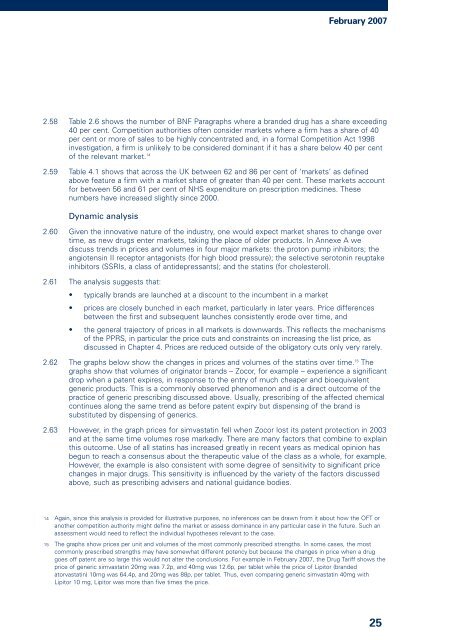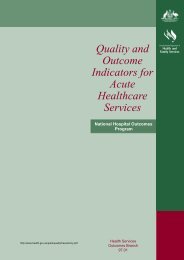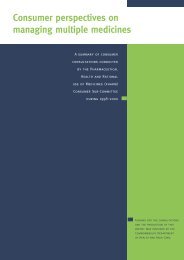The Pharmaceutical Price Regulation Scheme - Office of Fair Trading
The Pharmaceutical Price Regulation Scheme - Office of Fair Trading
The Pharmaceutical Price Regulation Scheme - Office of Fair Trading
Create successful ePaper yourself
Turn your PDF publications into a flip-book with our unique Google optimized e-Paper software.
February 2007<br />
2.58 Table 2.6 shows the number <strong>of</strong> BNF Paragraphs where a branded drug has a share exceeding<br />
40 per cent. Competition authorities <strong>of</strong>ten consider markets where a firm has a share <strong>of</strong> 40<br />
per cent or more <strong>of</strong> sales to be highly concentrated and, in a formal Competition Act 1998<br />
investigation, a firm is unlikely to be considered dominant if it has a share below 40 per cent<br />
<strong>of</strong> the relevant market. 14<br />
2.59 Table 4.1 shows that across the UK between 62 and 86 per cent <strong>of</strong> ‘markets’ as defined<br />
above feature a firm with a market share <strong>of</strong> greater than 40 per cent. <strong>The</strong>se markets account<br />
for between 56 and 61 per cent <strong>of</strong> NHS expenditure on prescription medicines. <strong>The</strong>se<br />
numbers have increased slightly since 2000.<br />
Dynamic analysis<br />
2.60 Given the innovative nature <strong>of</strong> the industry, one would expect market shares to change over<br />
time, as new drugs enter markets, taking the place <strong>of</strong> older products. In Annexe A we<br />
discuss trends in prices and volumes in four major markets: the proton pump inhibitors; the<br />
angiotensin II receptor antagonists (for high blood pressure); the selective serotonin reuptake<br />
inhibitors (SSRIs, a class <strong>of</strong> antidepressants); and the statins (for cholesterol).<br />
2.61 <strong>The</strong> analysis suggests that:<br />
• typically brands are launched at a discount to the incumbent in a market<br />
• prices are closely bunched in each market, particularly in later years. <strong>Price</strong> differences<br />
between the first and subsequent launches consistently erode over time, and<br />
• the general trajectory <strong>of</strong> prices in all markets is downwards. This reflects the mechanisms<br />
<strong>of</strong> the PPRS, in particular the price cuts and constraints on increasing the list price, as<br />
discussed in Chapter 4. <strong>Price</strong>s are reduced outside <strong>of</strong> the obligatory cuts only very rarely.<br />
2.62 <strong>The</strong> graphs below show the changes in prices and volumes <strong>of</strong> the statins over time. 15 <strong>The</strong><br />
graphs show that volumes <strong>of</strong> originator brands – Zocor, for example – experience a significant<br />
drop when a patent expires, in response to the entry <strong>of</strong> much cheaper and bioequivalent<br />
generic products. This is a commonly observed phenomenon and is a direct outcome <strong>of</strong> the<br />
practice <strong>of</strong> generic prescribing discussed above. Usually, prescribing <strong>of</strong> the affected chemical<br />
continues along the same trend as before patent expiry but dispensing <strong>of</strong> the brand is<br />
substituted by dispensing <strong>of</strong> generics.<br />
2.63 However, in the graph prices for simvastatin fell when Zocor lost its patent protection in 2003<br />
and at the same time volumes rose markedly. <strong>The</strong>re are many factors that combine to explain<br />
this outcome. Use <strong>of</strong> all statins has increased greatly in recent years as medical opinion has<br />
begun to reach a consensus about the therapeutic value <strong>of</strong> the class as a whole, for example.<br />
However, the example is also consistent with some degree <strong>of</strong> sensitivity to significant price<br />
changes in major drugs. This sensitivity is influenced by the variety <strong>of</strong> the factors discussed<br />
above, such as prescribing advisers and national guidance bodies.<br />
14 Again, since this analysis is provided for illustrative purposes, no inferences can be drawn from it about how the OFT or<br />
another competition authority might define the market or assess dominance in any particular case in the future. Such an<br />
assessment would need to reflect the individual hypotheses relevant to the case.<br />
15 <strong>The</strong> graphs show prices per unit and volumes <strong>of</strong> the most commonly prescribed strengths. In some cases, the most<br />
commonly prescribed strengths may have somewhat different potency but because the changes in price when a drug<br />
goes <strong>of</strong>f patent are so large this would not alter the conclusions. For example in February 2007, the Drug Tariff shows the<br />
price <strong>of</strong> generic simvastatin 20mg was 7.2p, and 40mg was 12.6p, per tablet while the price <strong>of</strong> Lipitor (branded<br />
atorvastatin) 10mg was 64.4p, and 20mg was 88p, per tablet. Thus, even comparing generic simvastatin 40mg with<br />
Lipitor 10 mg, Lipitor was more than five times the price.<br />
25




